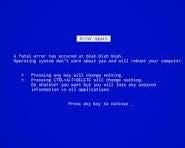A Journey Through Time: The History of the Blue Screen of Death

The Blue Screen of Death (BSoD), a dreaded sight for every Windows user, has a long and intriguing history. Over the years, it has become synonymous with system crashes and technical malfunctions. In this article, we will delve into the evolution of the Blue Screen of Death, exploring its origins, development, and the impact it has had on the world of computing.
Birth of the Blue Screen:
The Blue Screen of Death made its debut with the release of Windows 1.0 in 1985. However, it wasn’t until Windows 3.1 that the infamous blue screen error messages began to appear. During this early stage, the BSoD primarily served as a diagnostic tool for Microsoft developers, providing crucial information about system errors. It displayed cryptic codes and hexadecimal values, intended for technicians and programmers to identify the root causes of crashes.

Windows 95 and the Consumerization of Errors:
With the advent of Windows 95 in 1995, Microsoft aimed to make computing more accessible to the average user. As a part of this transition, the Blue Screen of Death underwent a transformation. Instead of presenting obscure error codes, the BSoD in Windows 95 featured friendlier language, attempting to explain the problem in a way that was more understandable for non-technical users. This shift marked the beginning of the consumerization of error messages.
Windows XP and the Notorious BSoD:
Windows XP, released in 2001, brought about significant changes to the Blue Screen of Death. The color remained blue, but the design became more modern and user-friendly. The BSoD in Windows XP featured a prominent error message, often accompanied by a stop code and a brief description of the problem. Despite these improvements, the Blue Screen of Death remained a symbol of system instability, prompting users to fear unexpected crashes and data loss.
Windows 7 and Beyond: Evolution Continues:
Subsequent Windows versions, including Windows 7, Windows 8, and Windows 10, continued to refine the Blue Screen of Death. Microsoft introduced new features such as automatic error reporting and recovery options to minimize the impact of system crashes. The BSoD itself became less frequent as operating systems became more stable, but its presence remained a reminder of the inherent complexities in computer systems.

Memorable BSoD Moments:
Over the years, the Blue Screen of Death has made appearances in various unexpected and sometimes humorous contexts. From movies and TV shows to public presentations, the BSoD has become a cultural symbol representing technical difficulties and system failures. Memorable instances include high-profile presentations by Microsoft executives where the BSoD made an untimely appearance, adding an element of irony to the situation.
BSoD in the Age of Technology:
As technology evolved, so did the nature of system errors. The Blue Screen of Death, once a common sight on BSoD desktop computers, began to fade into the background as smartphones and other devices took center stage. While the BSoD is less prevalent on modern operating systems, its legacy endures as a cautionary symbol of the potential pitfalls in the world of technology.

Conclusion:
The Blue Screen of Death, born out of the necessity for system diagnostics, has evolved from a cryptic tool for developers to a symbol of frustration for everyday users. Throughout its history, the BSoD has undergone transformations reflective of the changing landscape of computing. Despite the advancements in technology and operating systems, the Blue Screen of Death remains an iconic element of the digital experience, serving as a reminder that, in the complex world of technology, errors and crashes are an inevitable part of the journey.
Tagged:
blue screen ,
a blue screen
blue screen of death
blue screen of
blue screen screen
bsod screen
bsod blue screen of death
virus on pc
RELATED POSTS
Comments
Post a Comment